ENV616 Policy Brief: Bridging the Science-Policy Gap in Water Resource
VerifiedAdded on 2023/01/19
|9
|2189
|50
Report
AI Summary
This policy brief examines the critical gap between scientific research and policy making, particularly within the context of water resource management and the Clean Water Act in the USA. The assignment analyzes the Clean Water Act, highlighting its strengths in setting standards for clean water provision while also acknowledging its weaknesses, such as incomplete implementation and insufficient penalties for polluters. It emphasizes the importance of incorporating scientific evidence into policy development, addressing the science-policy gap, and outlining the negative consequences of disregarding scientific findings. The brief discusses the lack of political will, the need for evidence-based arguments, and the importance of a collaborative environment between scientists and policymakers to foster effective environmental policies. The policy brief suggests actionable steps for bridging this gap, emphasizing the importance of understanding scientific research and the need to prioritize environmental concerns over political interests. The document aims to provide recommendations on how to improve environmental policy making through the integration of scientific insights.
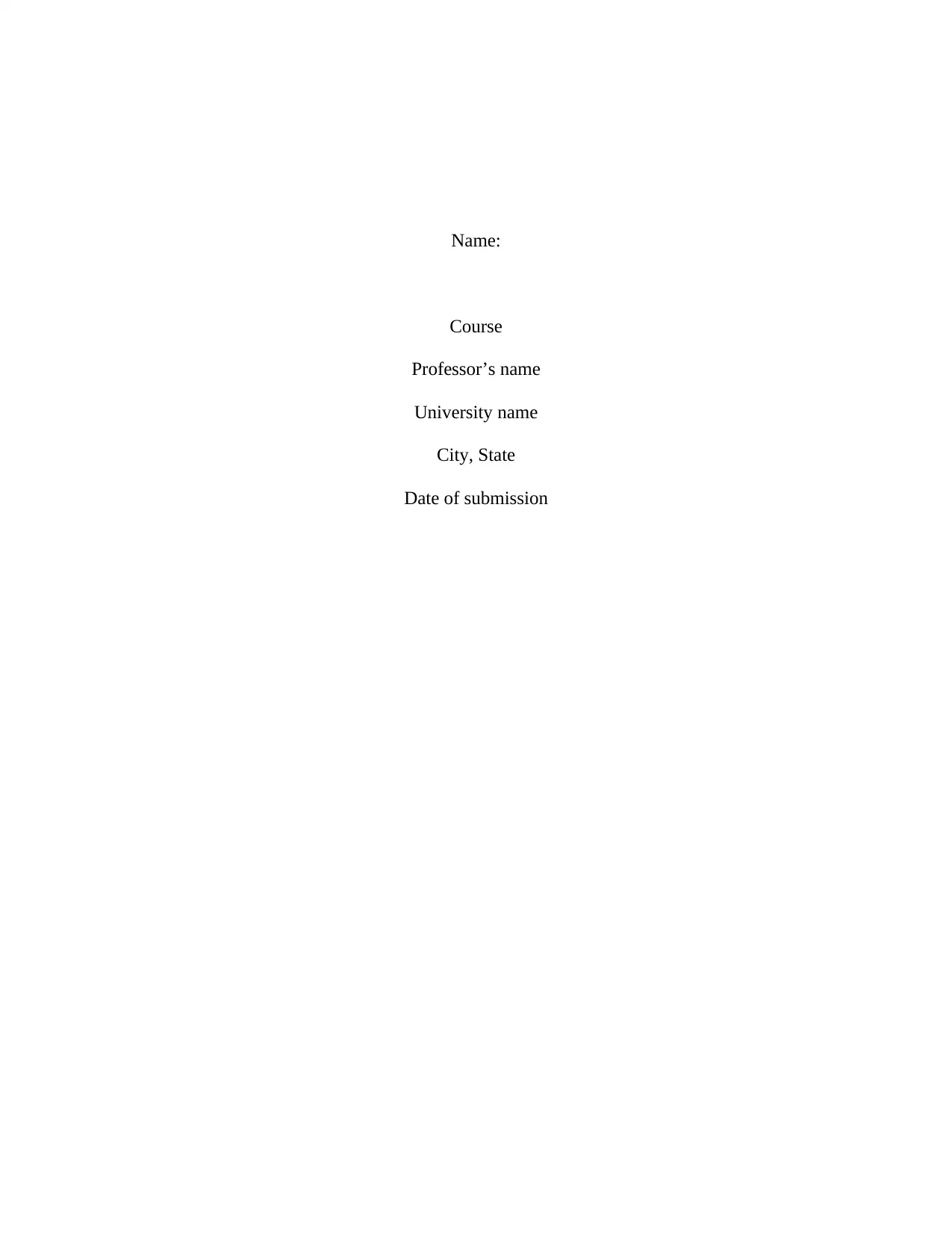
Name:
Course
Professor’s name
University name
City, State
Date of submission
Course
Professor’s name
University name
City, State
Date of submission
Paraphrase This Document
Need a fresh take? Get an instant paraphrase of this document with our AI Paraphraser
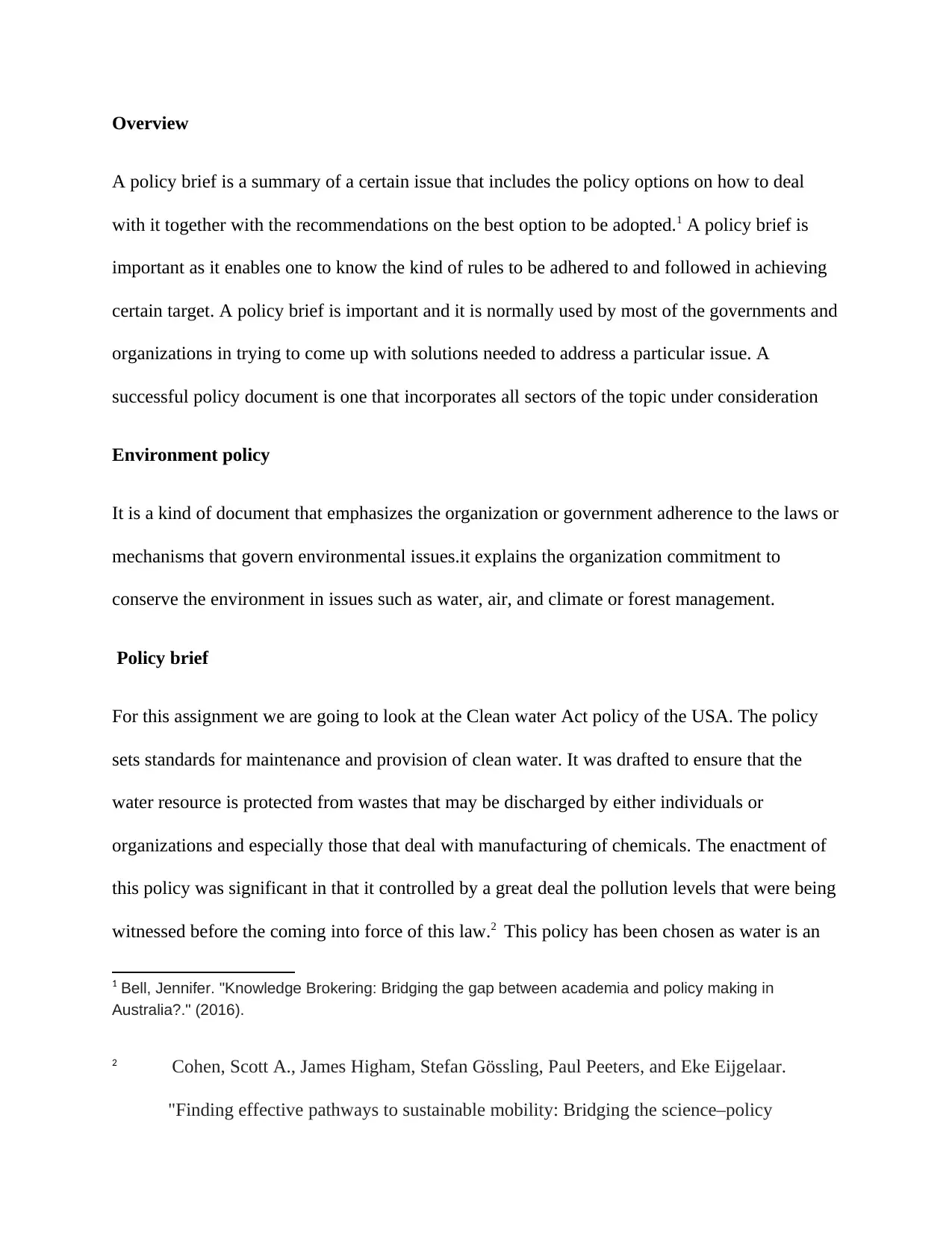
Overview
A policy brief is a summary of a certain issue that includes the policy options on how to deal
with it together with the recommendations on the best option to be adopted.1 A policy brief is
important as it enables one to know the kind of rules to be adhered to and followed in achieving
certain target. A policy brief is important and it is normally used by most of the governments and
organizations in trying to come up with solutions needed to address a particular issue. A
successful policy document is one that incorporates all sectors of the topic under consideration
Environment policy
It is a kind of document that emphasizes the organization or government adherence to the laws or
mechanisms that govern environmental issues.it explains the organization commitment to
conserve the environment in issues such as water, air, and climate or forest management.
Policy brief
For this assignment we are going to look at the Clean water Act policy of the USA. The policy
sets standards for maintenance and provision of clean water. It was drafted to ensure that the
water resource is protected from wastes that may be discharged by either individuals or
organizations and especially those that deal with manufacturing of chemicals. The enactment of
this policy was significant in that it controlled by a great deal the pollution levels that were being
witnessed before the coming into force of this law.2 This policy has been chosen as water is an
1 Bell, Jennifer. "Knowledge Brokering: Bridging the gap between academia and policy making in
Australia?." (2016).
2 Cohen, Scott A., James Higham, Stefan Gössling, Paul Peeters, and Eke Eijgelaar.
"Finding effective pathways to sustainable mobility: Bridging the science–policy
A policy brief is a summary of a certain issue that includes the policy options on how to deal
with it together with the recommendations on the best option to be adopted.1 A policy brief is
important as it enables one to know the kind of rules to be adhered to and followed in achieving
certain target. A policy brief is important and it is normally used by most of the governments and
organizations in trying to come up with solutions needed to address a particular issue. A
successful policy document is one that incorporates all sectors of the topic under consideration
Environment policy
It is a kind of document that emphasizes the organization or government adherence to the laws or
mechanisms that govern environmental issues.it explains the organization commitment to
conserve the environment in issues such as water, air, and climate or forest management.
Policy brief
For this assignment we are going to look at the Clean water Act policy of the USA. The policy
sets standards for maintenance and provision of clean water. It was drafted to ensure that the
water resource is protected from wastes that may be discharged by either individuals or
organizations and especially those that deal with manufacturing of chemicals. The enactment of
this policy was significant in that it controlled by a great deal the pollution levels that were being
witnessed before the coming into force of this law.2 This policy has been chosen as water is an
1 Bell, Jennifer. "Knowledge Brokering: Bridging the gap between academia and policy making in
Australia?." (2016).
2 Cohen, Scott A., James Higham, Stefan Gössling, Paul Peeters, and Eke Eijgelaar.
"Finding effective pathways to sustainable mobility: Bridging the science–policy
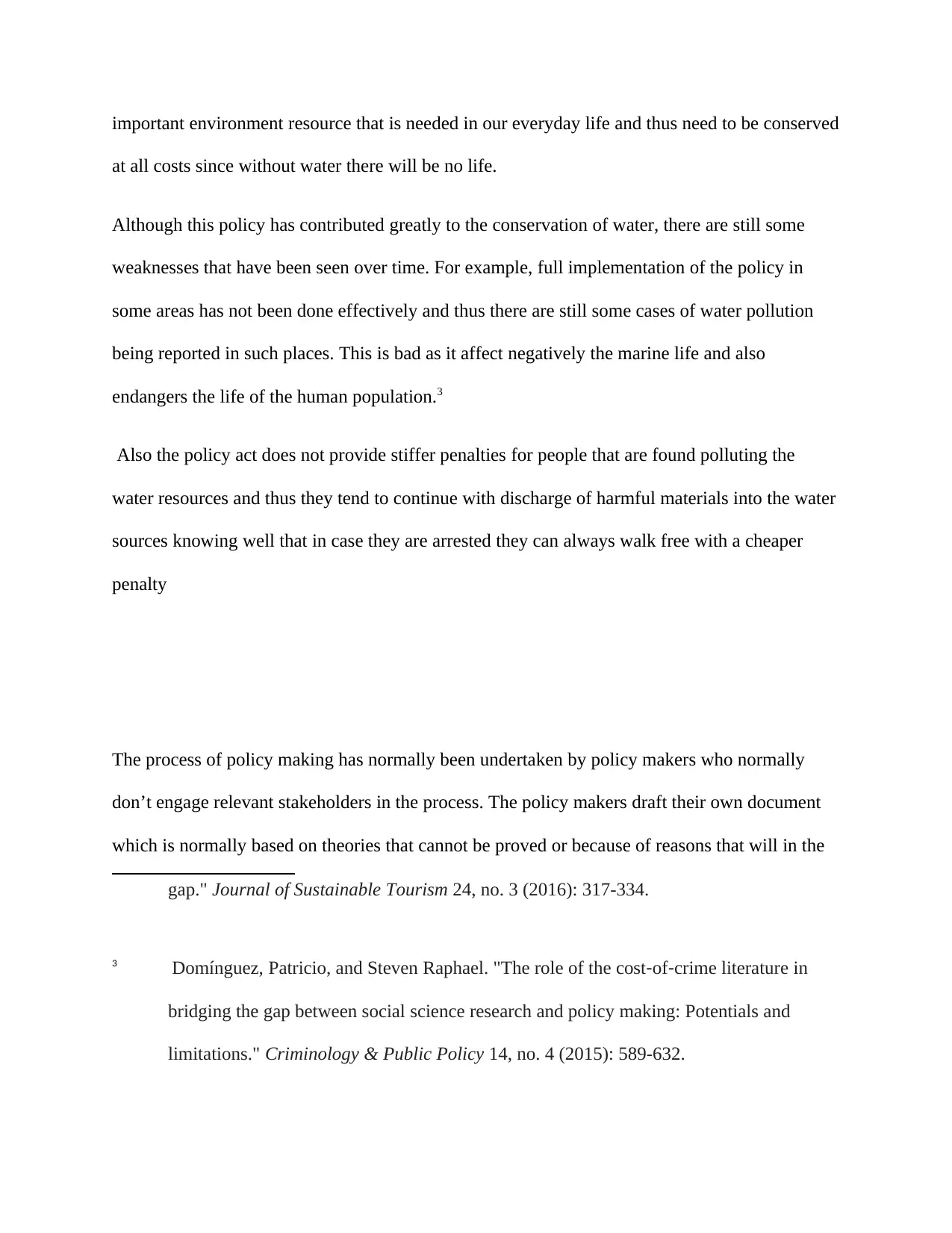
important environment resource that is needed in our everyday life and thus need to be conserved
at all costs since without water there will be no life.
Although this policy has contributed greatly to the conservation of water, there are still some
weaknesses that have been seen over time. For example, full implementation of the policy in
some areas has not been done effectively and thus there are still some cases of water pollution
being reported in such places. This is bad as it affect negatively the marine life and also
endangers the life of the human population.3
Also the policy act does not provide stiffer penalties for people that are found polluting the
water resources and thus they tend to continue with discharge of harmful materials into the water
sources knowing well that in case they are arrested they can always walk free with a cheaper
penalty
The process of policy making has normally been undertaken by policy makers who normally
don’t engage relevant stakeholders in the process. The policy makers draft their own document
which is normally based on theories that cannot be proved or because of reasons that will in the
gap." Journal of Sustainable Tourism 24, no. 3 (2016): 317-334.
3 Domínguez, Patricio, and Steven Raphael. "The role of the cost‐of‐crime literature in
bridging the gap between social science research and policy making: Potentials and
limitations." Criminology & Public Policy 14, no. 4 (2015): 589-632.
at all costs since without water there will be no life.
Although this policy has contributed greatly to the conservation of water, there are still some
weaknesses that have been seen over time. For example, full implementation of the policy in
some areas has not been done effectively and thus there are still some cases of water pollution
being reported in such places. This is bad as it affect negatively the marine life and also
endangers the life of the human population.3
Also the policy act does not provide stiffer penalties for people that are found polluting the
water resources and thus they tend to continue with discharge of harmful materials into the water
sources knowing well that in case they are arrested they can always walk free with a cheaper
penalty
The process of policy making has normally been undertaken by policy makers who normally
don’t engage relevant stakeholders in the process. The policy makers draft their own document
which is normally based on theories that cannot be proved or because of reasons that will in the
gap." Journal of Sustainable Tourism 24, no. 3 (2016): 317-334.
3 Domínguez, Patricio, and Steven Raphael. "The role of the cost‐of‐crime literature in
bridging the gap between social science research and policy making: Potentials and
limitations." Criminology & Public Policy 14, no. 4 (2015): 589-632.
⊘ This is a preview!⊘
Do you want full access?
Subscribe today to unlock all pages.

Trusted by 1+ million students worldwide
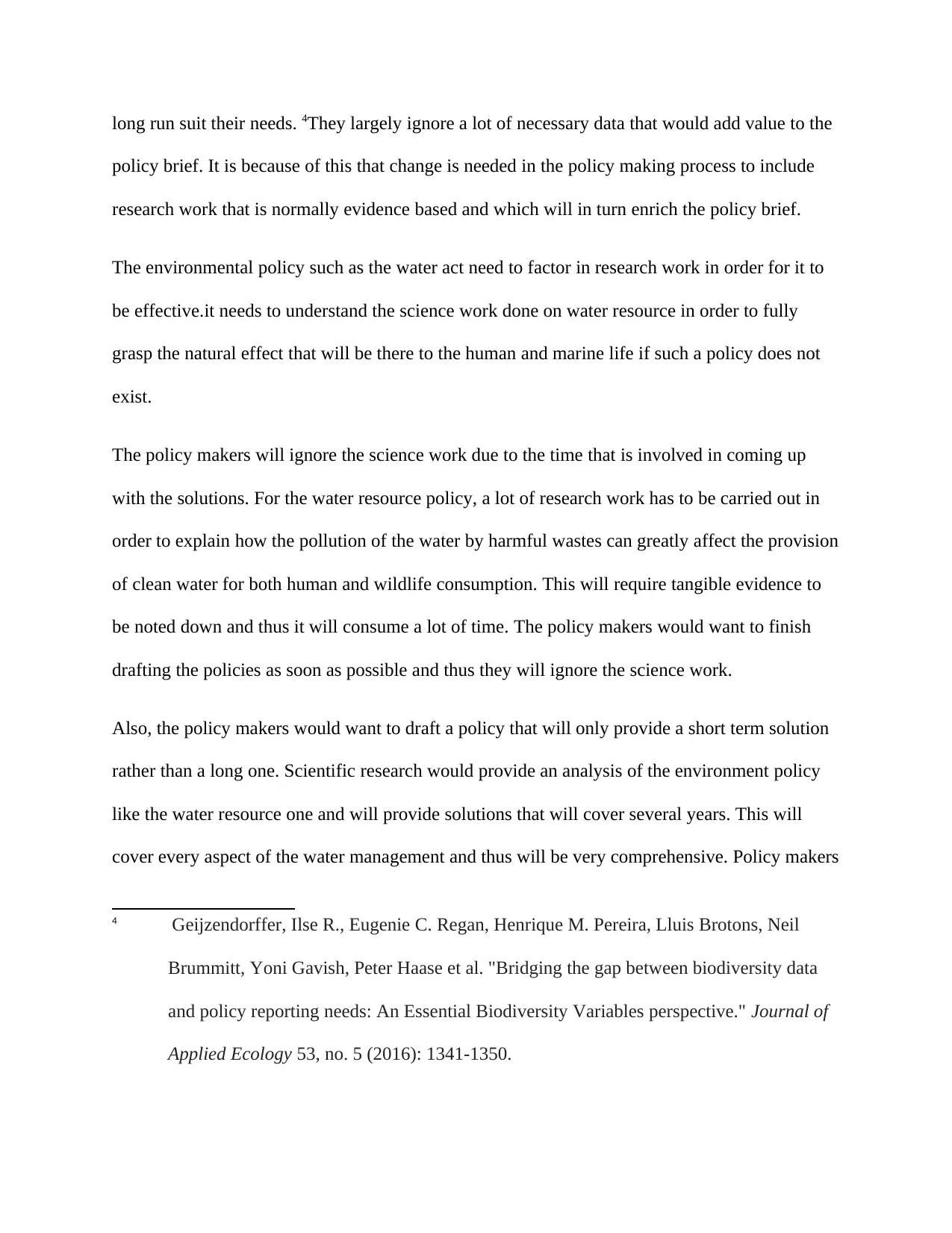
long run suit their needs. 4They largely ignore a lot of necessary data that would add value to the
policy brief. It is because of this that change is needed in the policy making process to include
research work that is normally evidence based and which will in turn enrich the policy brief.
The environmental policy such as the water act need to factor in research work in order for it to
be effective.it needs to understand the science work done on water resource in order to fully
grasp the natural effect that will be there to the human and marine life if such a policy does not
exist.
The policy makers will ignore the science work due to the time that is involved in coming up
with the solutions. For the water resource policy, a lot of research work has to be carried out in
order to explain how the pollution of the water by harmful wastes can greatly affect the provision
of clean water for both human and wildlife consumption. This will require tangible evidence to
be noted down and thus it will consume a lot of time. The policy makers would want to finish
drafting the policies as soon as possible and thus they will ignore the science work.
Also, the policy makers would want to draft a policy that will only provide a short term solution
rather than a long one. Scientific research would provide an analysis of the environment policy
like the water resource one and will provide solutions that will cover several years. This will
cover every aspect of the water management and thus will be very comprehensive. Policy makers
4 Geijzendorffer, Ilse R., Eugenie C. Regan, Henrique M. Pereira, Lluis Brotons, Neil
Brummitt, Yoni Gavish, Peter Haase et al. "Bridging the gap between biodiversity data
and policy reporting needs: An Essential Biodiversity Variables perspective." Journal of
Applied Ecology 53, no. 5 (2016): 1341-1350.
policy brief. It is because of this that change is needed in the policy making process to include
research work that is normally evidence based and which will in turn enrich the policy brief.
The environmental policy such as the water act need to factor in research work in order for it to
be effective.it needs to understand the science work done on water resource in order to fully
grasp the natural effect that will be there to the human and marine life if such a policy does not
exist.
The policy makers will ignore the science work due to the time that is involved in coming up
with the solutions. For the water resource policy, a lot of research work has to be carried out in
order to explain how the pollution of the water by harmful wastes can greatly affect the provision
of clean water for both human and wildlife consumption. This will require tangible evidence to
be noted down and thus it will consume a lot of time. The policy makers would want to finish
drafting the policies as soon as possible and thus they will ignore the science work.
Also, the policy makers would want to draft a policy that will only provide a short term solution
rather than a long one. Scientific research would provide an analysis of the environment policy
like the water resource one and will provide solutions that will cover several years. This will
cover every aspect of the water management and thus will be very comprehensive. Policy makers
4 Geijzendorffer, Ilse R., Eugenie C. Regan, Henrique M. Pereira, Lluis Brotons, Neil
Brummitt, Yoni Gavish, Peter Haase et al. "Bridging the gap between biodiversity data
and policy reporting needs: An Essential Biodiversity Variables perspective." Journal of
Applied Ecology 53, no. 5 (2016): 1341-1350.
Paraphrase This Document
Need a fresh take? Get an instant paraphrase of this document with our AI Paraphraser
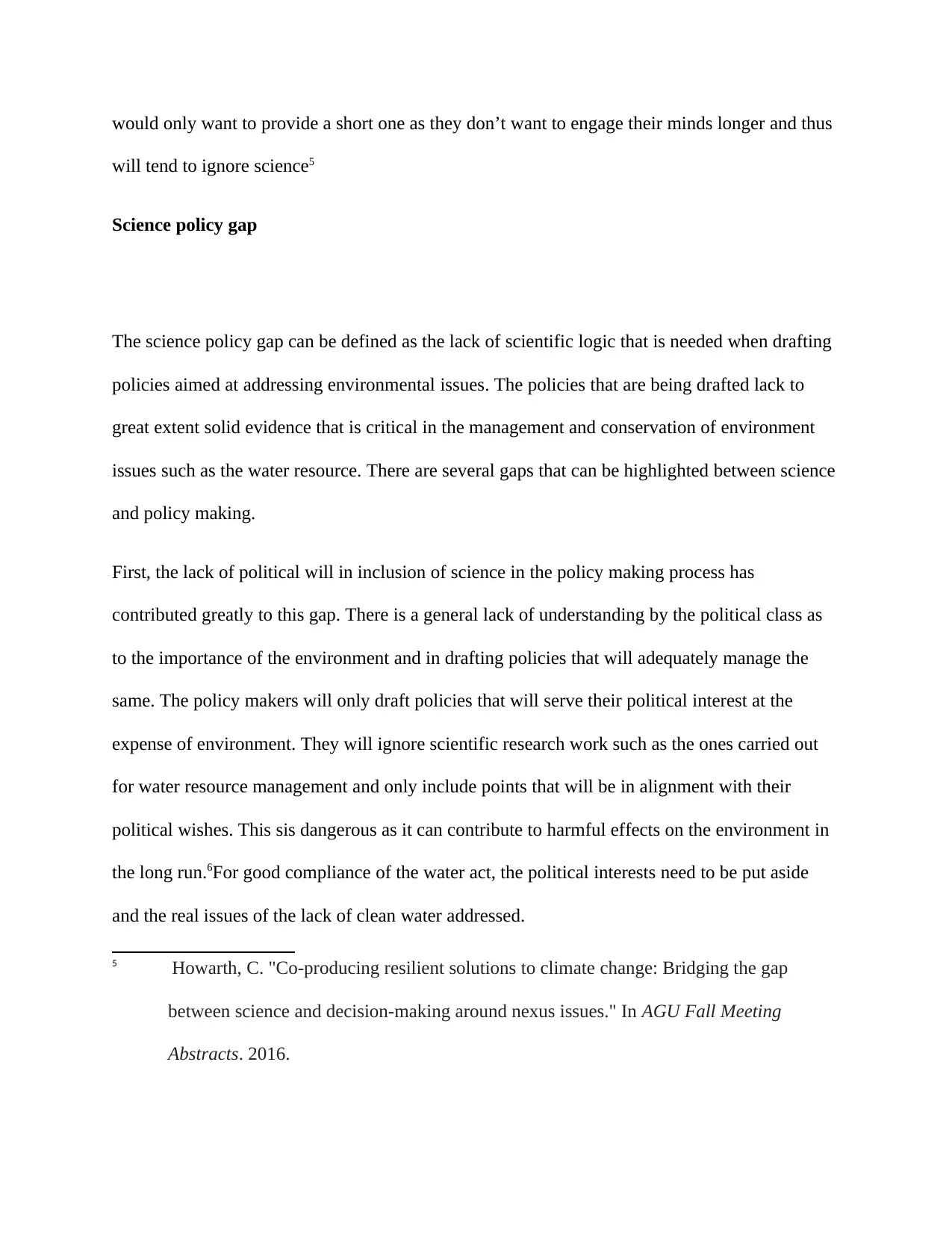
would only want to provide a short one as they don’t want to engage their minds longer and thus
will tend to ignore science5
Science policy gap
The science policy gap can be defined as the lack of scientific logic that is needed when drafting
policies aimed at addressing environmental issues. The policies that are being drafted lack to
great extent solid evidence that is critical in the management and conservation of environment
issues such as the water resource. There are several gaps that can be highlighted between science
and policy making.
First, the lack of political will in inclusion of science in the policy making process has
contributed greatly to this gap. There is a general lack of understanding by the political class as
to the importance of the environment and in drafting policies that will adequately manage the
same. The policy makers will only draft policies that will serve their political interest at the
expense of environment. They will ignore scientific research work such as the ones carried out
for water resource management and only include points that will be in alignment with their
political wishes. This sis dangerous as it can contribute to harmful effects on the environment in
the long run.6For good compliance of the water act, the political interests need to be put aside
and the real issues of the lack of clean water addressed.
5 Howarth, C. "Co-producing resilient solutions to climate change: Bridging the gap
between science and decision-making around nexus issues." In AGU Fall Meeting
Abstracts. 2016.
will tend to ignore science5
Science policy gap
The science policy gap can be defined as the lack of scientific logic that is needed when drafting
policies aimed at addressing environmental issues. The policies that are being drafted lack to
great extent solid evidence that is critical in the management and conservation of environment
issues such as the water resource. There are several gaps that can be highlighted between science
and policy making.
First, the lack of political will in inclusion of science in the policy making process has
contributed greatly to this gap. There is a general lack of understanding by the political class as
to the importance of the environment and in drafting policies that will adequately manage the
same. The policy makers will only draft policies that will serve their political interest at the
expense of environment. They will ignore scientific research work such as the ones carried out
for water resource management and only include points that will be in alignment with their
political wishes. This sis dangerous as it can contribute to harmful effects on the environment in
the long run.6For good compliance of the water act, the political interests need to be put aside
and the real issues of the lack of clean water addressed.
5 Howarth, C. "Co-producing resilient solutions to climate change: Bridging the gap
between science and decision-making around nexus issues." In AGU Fall Meeting
Abstracts. 2016.
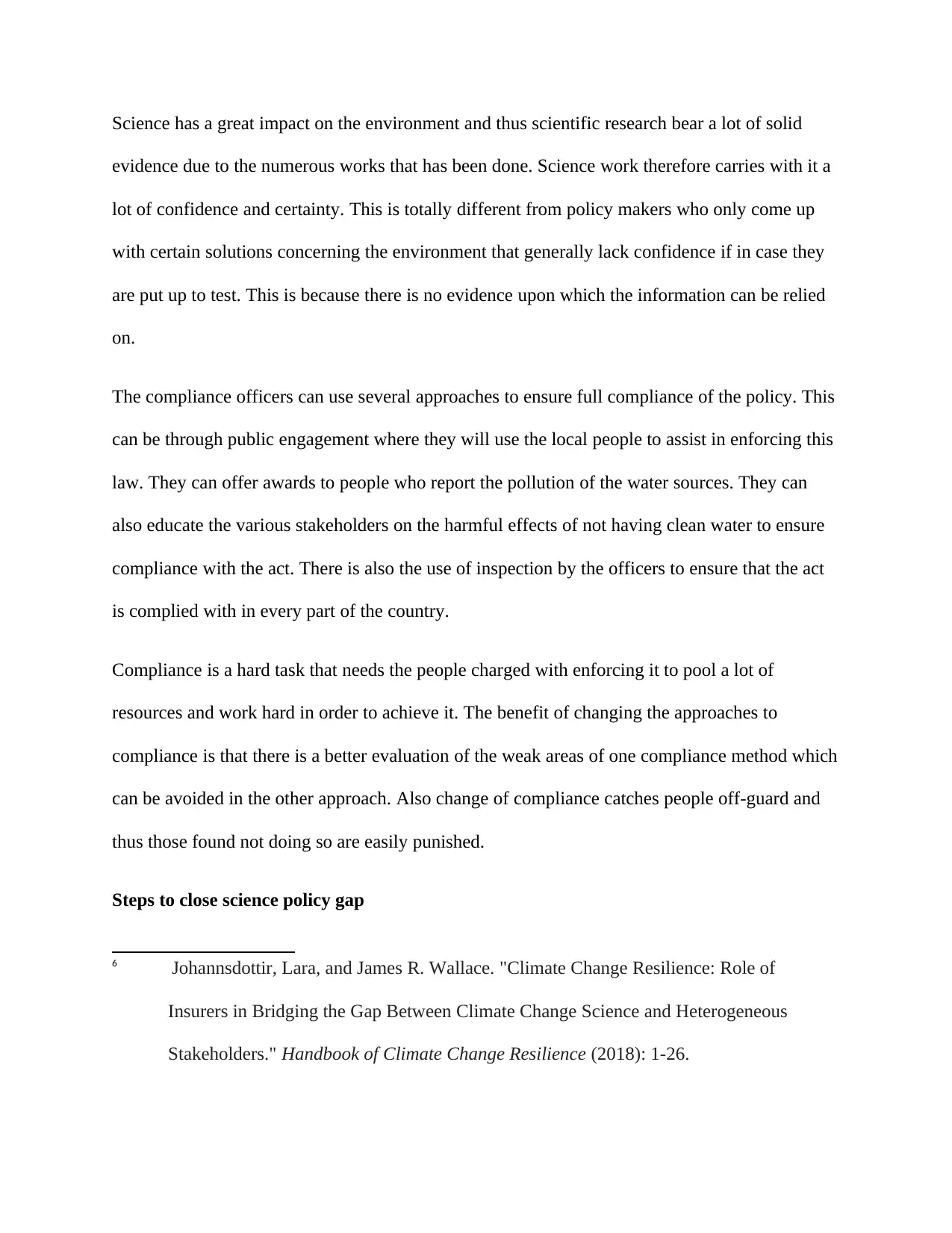
Science has a great impact on the environment and thus scientific research bear a lot of solid
evidence due to the numerous works that has been done. Science work therefore carries with it a
lot of confidence and certainty. This is totally different from policy makers who only come up
with certain solutions concerning the environment that generally lack confidence if in case they
are put up to test. This is because there is no evidence upon which the information can be relied
on.
The compliance officers can use several approaches to ensure full compliance of the policy. This
can be through public engagement where they will use the local people to assist in enforcing this
law. They can offer awards to people who report the pollution of the water sources. They can
also educate the various stakeholders on the harmful effects of not having clean water to ensure
compliance with the act. There is also the use of inspection by the officers to ensure that the act
is complied with in every part of the country.
Compliance is a hard task that needs the people charged with enforcing it to pool a lot of
resources and work hard in order to achieve it. The benefit of changing the approaches to
compliance is that there is a better evaluation of the weak areas of one compliance method which
can be avoided in the other approach. Also change of compliance catches people off-guard and
thus those found not doing so are easily punished.
Steps to close science policy gap
6 Johannsdottir, Lara, and James R. Wallace. "Climate Change Resilience: Role of
Insurers in Bridging the Gap Between Climate Change Science and Heterogeneous
Stakeholders." Handbook of Climate Change Resilience (2018): 1-26.
evidence due to the numerous works that has been done. Science work therefore carries with it a
lot of confidence and certainty. This is totally different from policy makers who only come up
with certain solutions concerning the environment that generally lack confidence if in case they
are put up to test. This is because there is no evidence upon which the information can be relied
on.
The compliance officers can use several approaches to ensure full compliance of the policy. This
can be through public engagement where they will use the local people to assist in enforcing this
law. They can offer awards to people who report the pollution of the water sources. They can
also educate the various stakeholders on the harmful effects of not having clean water to ensure
compliance with the act. There is also the use of inspection by the officers to ensure that the act
is complied with in every part of the country.
Compliance is a hard task that needs the people charged with enforcing it to pool a lot of
resources and work hard in order to achieve it. The benefit of changing the approaches to
compliance is that there is a better evaluation of the weak areas of one compliance method which
can be avoided in the other approach. Also change of compliance catches people off-guard and
thus those found not doing so are easily punished.
Steps to close science policy gap
6 Johannsdottir, Lara, and James R. Wallace. "Climate Change Resilience: Role of
Insurers in Bridging the Gap Between Climate Change Science and Heterogeneous
Stakeholders." Handbook of Climate Change Resilience (2018): 1-26.
⊘ This is a preview!⊘
Do you want full access?
Subscribe today to unlock all pages.

Trusted by 1+ million students worldwide
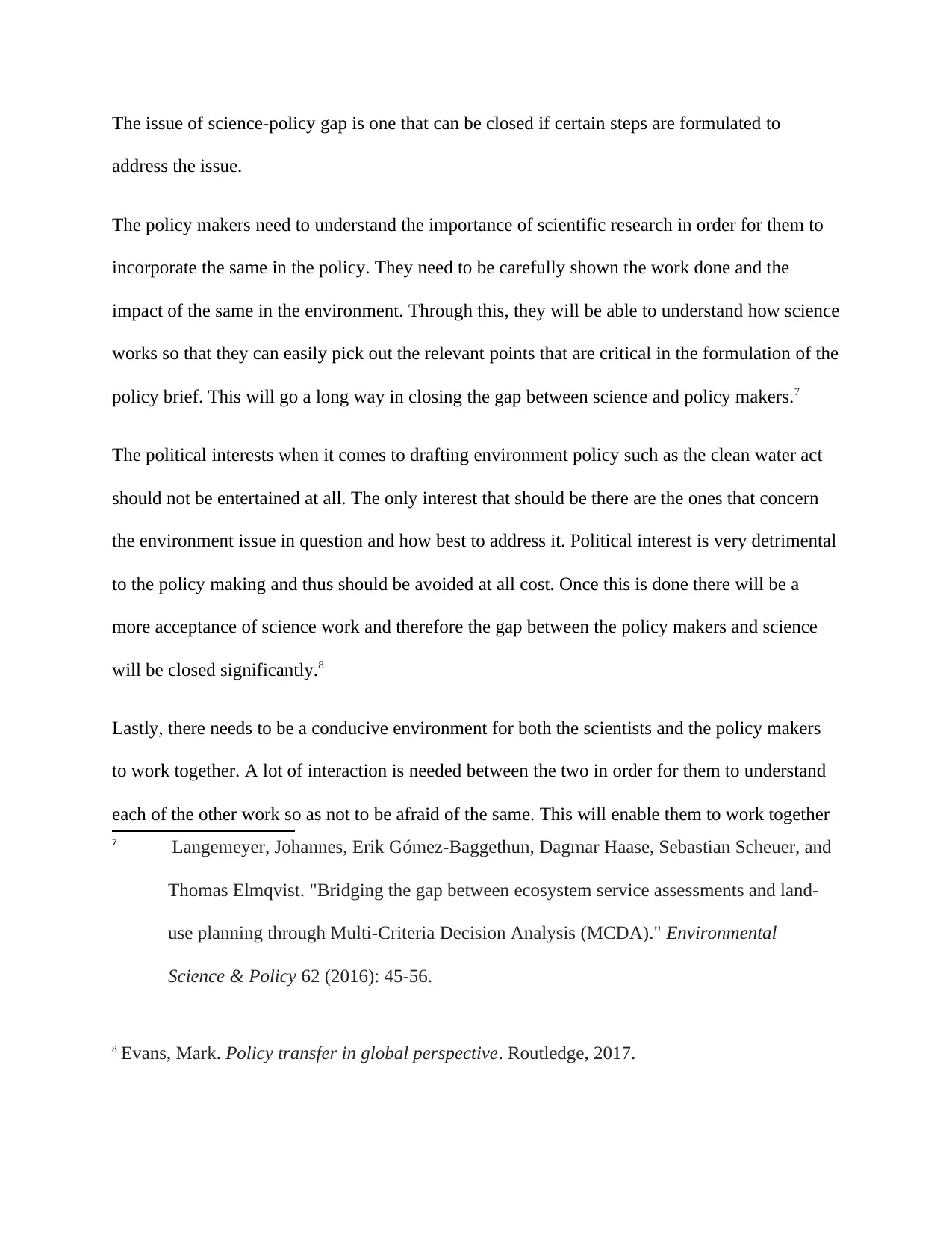
The issue of science-policy gap is one that can be closed if certain steps are formulated to
address the issue.
The policy makers need to understand the importance of scientific research in order for them to
incorporate the same in the policy. They need to be carefully shown the work done and the
impact of the same in the environment. Through this, they will be able to understand how science
works so that they can easily pick out the relevant points that are critical in the formulation of the
policy brief. This will go a long way in closing the gap between science and policy makers.7
The political interests when it comes to drafting environment policy such as the clean water act
should not be entertained at all. The only interest that should be there are the ones that concern
the environment issue in question and how best to address it. Political interest is very detrimental
to the policy making and thus should be avoided at all cost. Once this is done there will be a
more acceptance of science work and therefore the gap between the policy makers and science
will be closed significantly.8
Lastly, there needs to be a conducive environment for both the scientists and the policy makers
to work together. A lot of interaction is needed between the two in order for them to understand
each of the other work so as not to be afraid of the same. This will enable them to work together
7 Langemeyer, Johannes, Erik Gómez-Baggethun, Dagmar Haase, Sebastian Scheuer, and
Thomas Elmqvist. "Bridging the gap between ecosystem service assessments and land-
use planning through Multi-Criteria Decision Analysis (MCDA)." Environmental
Science & Policy 62 (2016): 45-56.
8 Evans, Mark. Policy transfer in global perspective. Routledge, 2017.
address the issue.
The policy makers need to understand the importance of scientific research in order for them to
incorporate the same in the policy. They need to be carefully shown the work done and the
impact of the same in the environment. Through this, they will be able to understand how science
works so that they can easily pick out the relevant points that are critical in the formulation of the
policy brief. This will go a long way in closing the gap between science and policy makers.7
The political interests when it comes to drafting environment policy such as the clean water act
should not be entertained at all. The only interest that should be there are the ones that concern
the environment issue in question and how best to address it. Political interest is very detrimental
to the policy making and thus should be avoided at all cost. Once this is done there will be a
more acceptance of science work and therefore the gap between the policy makers and science
will be closed significantly.8
Lastly, there needs to be a conducive environment for both the scientists and the policy makers
to work together. A lot of interaction is needed between the two in order for them to understand
each of the other work so as not to be afraid of the same. This will enable them to work together
7 Langemeyer, Johannes, Erik Gómez-Baggethun, Dagmar Haase, Sebastian Scheuer, and
Thomas Elmqvist. "Bridging the gap between ecosystem service assessments and land-
use planning through Multi-Criteria Decision Analysis (MCDA)." Environmental
Science & Policy 62 (2016): 45-56.
8 Evans, Mark. Policy transfer in global perspective. Routledge, 2017.
Paraphrase This Document
Need a fresh take? Get an instant paraphrase of this document with our AI Paraphraser
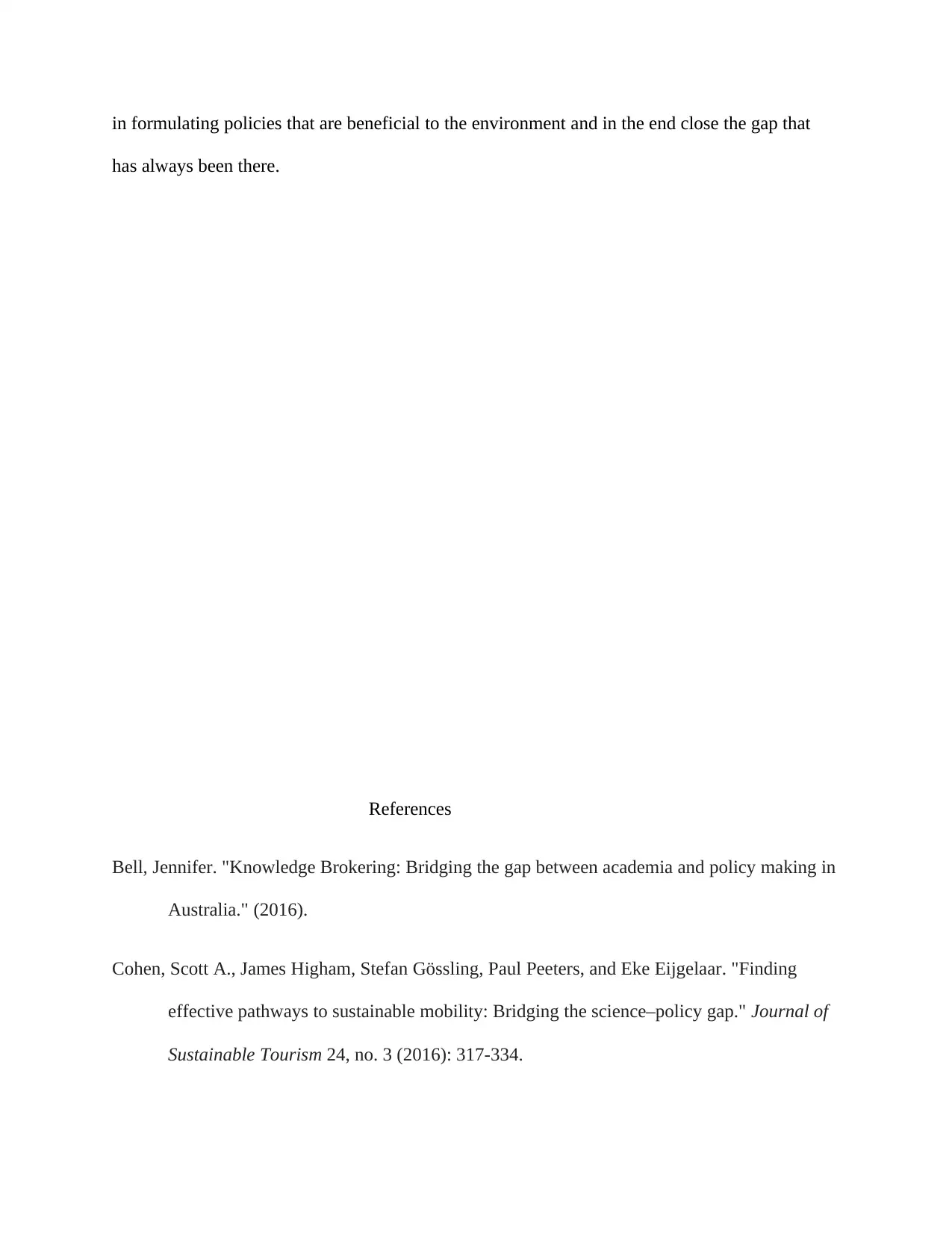
in formulating policies that are beneficial to the environment and in the end close the gap that
has always been there.
References
Bell, Jennifer. "Knowledge Brokering: Bridging the gap between academia and policy making in
Australia." (2016).
Cohen, Scott A., James Higham, Stefan Gössling, Paul Peeters, and Eke Eijgelaar. "Finding
effective pathways to sustainable mobility: Bridging the science–policy gap." Journal of
Sustainable Tourism 24, no. 3 (2016): 317-334.
has always been there.
References
Bell, Jennifer. "Knowledge Brokering: Bridging the gap between academia and policy making in
Australia." (2016).
Cohen, Scott A., James Higham, Stefan Gössling, Paul Peeters, and Eke Eijgelaar. "Finding
effective pathways to sustainable mobility: Bridging the science–policy gap." Journal of
Sustainable Tourism 24, no. 3 (2016): 317-334.
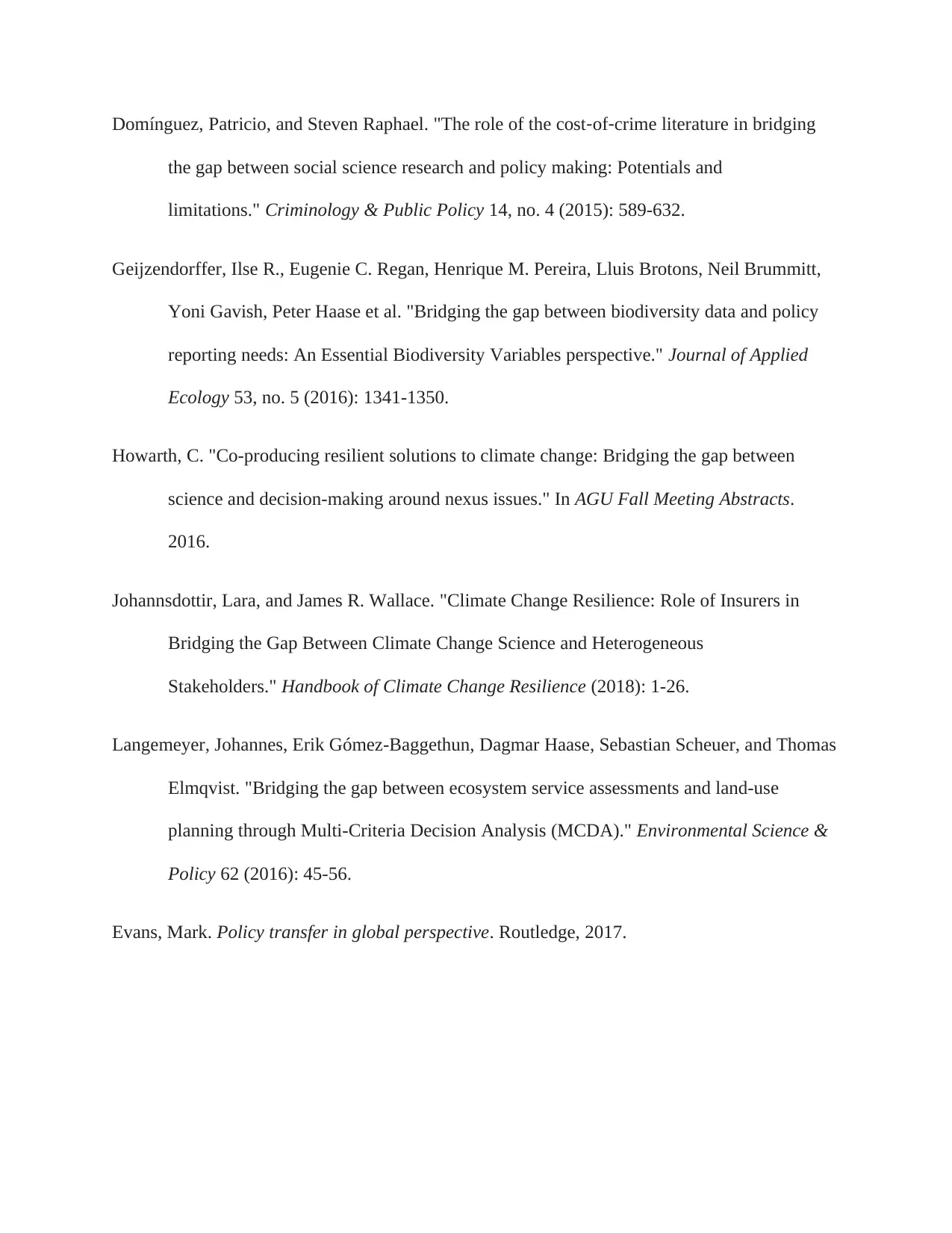
Domínguez, Patricio, and Steven Raphael. "The role of the cost‐of‐crime literature in bridging
the gap between social science research and policy making: Potentials and
limitations." Criminology & Public Policy 14, no. 4 (2015): 589-632.
Geijzendorffer, Ilse R., Eugenie C. Regan, Henrique M. Pereira, Lluis Brotons, Neil Brummitt,
Yoni Gavish, Peter Haase et al. "Bridging the gap between biodiversity data and policy
reporting needs: An Essential Biodiversity Variables perspective." Journal of Applied
Ecology 53, no. 5 (2016): 1341-1350.
Howarth, C. "Co-producing resilient solutions to climate change: Bridging the gap between
science and decision-making around nexus issues." In AGU Fall Meeting Abstracts.
2016.
Johannsdottir, Lara, and James R. Wallace. "Climate Change Resilience: Role of Insurers in
Bridging the Gap Between Climate Change Science and Heterogeneous
Stakeholders." Handbook of Climate Change Resilience (2018): 1-26.
Langemeyer, Johannes, Erik Gómez-Baggethun, Dagmar Haase, Sebastian Scheuer, and Thomas
Elmqvist. "Bridging the gap between ecosystem service assessments and land-use
planning through Multi-Criteria Decision Analysis (MCDA)." Environmental Science &
Policy 62 (2016): 45-56.
Evans, Mark. Policy transfer in global perspective. Routledge, 2017.
the gap between social science research and policy making: Potentials and
limitations." Criminology & Public Policy 14, no. 4 (2015): 589-632.
Geijzendorffer, Ilse R., Eugenie C. Regan, Henrique M. Pereira, Lluis Brotons, Neil Brummitt,
Yoni Gavish, Peter Haase et al. "Bridging the gap between biodiversity data and policy
reporting needs: An Essential Biodiversity Variables perspective." Journal of Applied
Ecology 53, no. 5 (2016): 1341-1350.
Howarth, C. "Co-producing resilient solutions to climate change: Bridging the gap between
science and decision-making around nexus issues." In AGU Fall Meeting Abstracts.
2016.
Johannsdottir, Lara, and James R. Wallace. "Climate Change Resilience: Role of Insurers in
Bridging the Gap Between Climate Change Science and Heterogeneous
Stakeholders." Handbook of Climate Change Resilience (2018): 1-26.
Langemeyer, Johannes, Erik Gómez-Baggethun, Dagmar Haase, Sebastian Scheuer, and Thomas
Elmqvist. "Bridging the gap between ecosystem service assessments and land-use
planning through Multi-Criteria Decision Analysis (MCDA)." Environmental Science &
Policy 62 (2016): 45-56.
Evans, Mark. Policy transfer in global perspective. Routledge, 2017.
⊘ This is a preview!⊘
Do you want full access?
Subscribe today to unlock all pages.

Trusted by 1+ million students worldwide
1 out of 9
Your All-in-One AI-Powered Toolkit for Academic Success.
+13062052269
info@desklib.com
Available 24*7 on WhatsApp / Email
![[object Object]](/_next/static/media/star-bottom.7253800d.svg)
Unlock your academic potential
Copyright © 2020–2025 A2Z Services. All Rights Reserved. Developed and managed by ZUCOL.